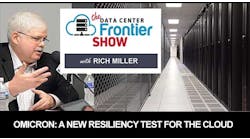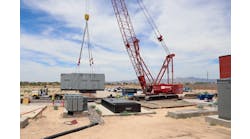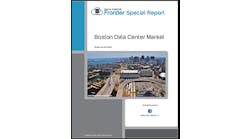Executive Roundtable: The Lasting Impact of the COVID-19 Pandemic
Welcome to our 21st Data Center Executive Roundtable, a quarterly feature showcasing the insights of thought leaders on the state of the data center industry, and where it is headed. Our Fourth Quarter 2020 roundtable offers insights on four topics: The lasting impact of the COVID-19 pandemic, enterprise IT spending amid digital acceleration, how sustainability may change the data center industry, and predictions for what may surprise us in 2021.
Here’s a look at our distinguished panel:
- John Sabey, CEO of Sabey Corporation, parent of Sabey Data Centers
- Jeff Klaus, General Manager of Intel Data Center Software Solutions
- Maricel Cerruti, Principal and Director at Teladata, and founding board member at Infrastructure Masons
- Todd Schneider, Director of Product Management at Chatsworth Products Inc.
- Ben Stewart, Senior Vice President of Operations at NTT Global Data Centers Americas
- Kris Holla, Group Vice President, Channel Sales, Nortek Data Center Cooling.
- Michael DeVito, VP, Global Sales & Marketing at Iron Mountain Data Centers
The conversation is moderated by Rich Miller, the founder and editor of Data Center Frontier. Each day this week we will present a Q&A with these executives on one of our key topics. We begin with a look at our panel’s take on the continuing lessons of the COVID-19 pandemic.
Data Center Frontier: The COVID-19 pandemic has defined much of 2020. As we enter 2021, what pandemic-related changes are likely to have lasting impact for the data center industry, and why?
JOHN SABEY, Sabey Corporation
John Sabey (Sabey Corp.) : Of the many changes necessitated by the pandemic in 2020, the one most likely to “stick” happens to also be the one most likely to having a lasting effect on our industry: the near global transition to a distributed workforce.
Even as vaccines roll out, restrictions subside, and employees return to workplaces on a more regular basis, the habits we formed and adaptations we made during the lockdowns will continue to shape the modern workforce for the foreseeable future. Ultimately, this massive transition of business toward workplace flexibility was enabled by digital connectivity and the massive adoption of new technologies, both of which drive data center demand.
We have all developed new habits this year, even in our personal lives – online shopping, meal delivery, less travel, meeting virtually, video streaming – that won’t be easily broken, and whose growth has and will rely on the expansion of the data center industry.
Another COVID-driven innovation that is particularly near and dear to the hearts of us at Sabey are the vaccines themselves. Due to our company’s unique position at the intersection of life sciences and technology, we watched with great interest as high performance compute (HPC) and global collaboration enabled such an accelerated vaccine development cycle, particularly for the first-ever vaccines based on messenger RNA. If mRNA proves to be the key to unlocking an entirely new platform for preventing and eradicating disease, this pandemic will have provided yet another test case for HPC, driving future data center capacity demand.
KRIS HOLLA, Nortek Air Solutions
Kris Holla (Nortek): The workspace has been changed forever, because COVID-19 has accelerated the digital revolution. The data center has become the supportive backbone and pillar of this revolution. More than 40-percent of people who once worked 40-hour weeks in an office, are expected to continue home office working part or full time once COVID-19 declines in 2021. This might spell a future problem for office space leasing, but it is great news for the data center industry’s continued growth.
Parallel to this change in work environments is the transition from personal computers to working from the cloud. With this transformation, these workers will need proper data collection, increased data privacy and security, broader bandwidths, less latency and all the other needed home office tools and capabilities that require more data center power. Things that were unheard of five years ago will become the new normal, such as training and supplying the workforce to work in a virtual work environment.
“The workspace has been changed forever, because COVID-19 has accelerated the digital revolution. The data center has become the pillar of this revolution.”
Kris Holla, Nortek Air Solutions
All of these cultural changes mandate more capacity, especially with the emergence of the 5G network. Amid all of this change, the challenge facing operators is cooling equipment that must mitigate the additional heat generated from these cultural work trends, not to mention AI, autonomous vehicles, gaming and other oncoming power-consuming paradigms. Consequently, cooling capacity, efficiency, cost-effectiveness and sustainability will directly affect data center industry’s future profitability.
JEFF KLAUS, Intel
Jeff Klaus (Intel): The push to cloud services has been significant and will continue next year. I don’t see any competing force to change that direction at the moment.
Also, I think companies will continue to have challenges in retaining talent and finding new people with the appropriate cloud skills, so companies will need to get creative with incentives and recognition to build loyalty.
Finally I think security will be a larger challenge considering the rush to cloud and continued profit derived from attacks.
MARICEL CERRUTI, Teladata and Infrastructure Masons
Maricel Cerruti (Infrastructure Masons): The good news for the data center industry is that the COVID-19 pandemic brought to the spotlight the importance of technology in allowing businesses to continue to function in a digital world. As a result, the demand for data center capacity and migration to the cloud will only continue to grow at a tremendous rate.
This is placing an increased pressure in the data center industry to meet client contract commitments while dealing with limited people resources, supply chain disruptions, operations, and construction challenges due to pandemic restrictions. That is why as we enter 2021, there will continue to be a major focus on disaster recovery, business continuity, and attracting/retaining talent to keep up with exponential growth in this industry.
The pandemic forced many data center operators to re-examine their existing procedures, processes, supply chains, and local resources to improve readiness and operations. Like other business sectors, the data center industry will continue to re-evaluate their existing supply chain models to better understand the deeper layers in their eco system that can potentially create critical bottlenecks, improve real-time visibility, and diversify partners so they are not dependent on raw materials and products sourced from one single geographic location.
“As we enter 2021, there will be a major focus on disaster recovery, business continuity, and attracting/retaining talent to keep up with the exponential growth in this industry.”
Maricel Cerruti, Infrastructure Masons
In the long term, technology leaders will continue to invest in more automation, monitoring, and tools to allow for more remote management and to enable data centers to be resilient in an unpredictable new environment.
It is also undeniable there is a talent deficit in this industry and the need to attract and retain qualified people are critical to keep up with demand and growth. Fortunately, there are non-profit organizations such as Infrastructure Masons (IM), helping to bring awareness to this industry and committed to leveraging and developing under-utilized sources of talent- women, veterans, millennials, and other underrepresented minority groups in the global digital infrastructure industry.
MICHAEL DeVITO, Iron Mountain
Michael DeVito (Iron Montain): There are multiple aspects of the pandemic that are lasting for the industry. To start, you see that working from home has an impact on many of us that used to go into the office on a daily basis, that are now working remotely. This will stay to some capacity, with several larger enterprises already announcing that their workforce will keep working from home for the foreseeable future.
This has and will continue to fuel the need for data center services, with more people than ever leveraging cloud, gaming, streaming and online shopping services etc.. from their homes. The connectivity and infrastructure services uptick we saw earlier in the year, will be permanent and is part of a continuing hyperscale surge that leads this wave.
In short, we have brought forward anticipated future growth in 2020 due to the pandemic.
TODD SCHNEIDER, Chatsworth Products
Todd Schneider (Chatsworth Products): Continuous operations have always been integral in the data center industry, so most data centers understand what it takes to support customers 24×7. However, the COVID-19 pandemic has forced many companies to shift to work-from-home distributed workforces. This move has driven an increased demand for cloud services that support real-time collaboration and business operations. As a result, we see the need for leased space in multitenant data centers growing significantly. While this shift to an expanded footprint was on most company roadmaps, the pandemic greatly accelerated a more immediate need. As a result, more remote employees, limited travel and additional sites have all made remote power management and control increasingly more important.
Many larger data centers already base their operations on an intelligent power management strategy. This can include UPSs, power distribution units with monitoring capabilities and DCIM software that acts like a viewing window into what is happening on site when workers aren’t present. But now, smaller operators and colocation providers are beginning to understand the full benefits of deploying intelligent power products, which greatly offset the upfront cost investment. A good example is the ability to remotely reboot and commission equipment – even monitor physical access – without the need to send remote-hands service. This can all be controlled, monitored and reported remotely, minimizing the risk of unnecessary exposure to personnel on site.
At the macro level, organizations will continue to rely on a mix of enterprise-owned, cloud-based and edge services. While we expect the trend for cloud services and colocation to keep growing, those who must be on site will likely continue requiring PPE usage, screening and contact tracing methods well into 2021.
BEN STEWART, NTT Global Data Centers, Americas
Ben Stewart (NTT Global Data Centers Americas): We’re much more comprehensive in how we manage our resources today, factoring in the very real possibility of losing our critical facility staff to a wave of infections. Personal protective protocols, cross-training, distancing, intense scrutiny over who has site access – when and for how long – are a few examples of the operational improvements we’ve employed during this COVID crisis.
However, is there a good reason to relax any of that when this crisis passes, having no idea when the next calamity may strike? Surely some procedural components may be relaxed, but others are likely to become the new standard operating procedures.
NEXT: The outlook for enterprise IT spending in 2021.
Keep pace with the fact-moving world of data centers and cloud computing by following us on Twitter and Facebook, connecting with me on LinkedIn, and signing up for our weekly newspaper using the form below:







